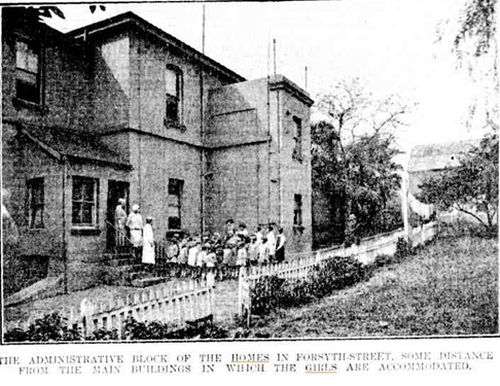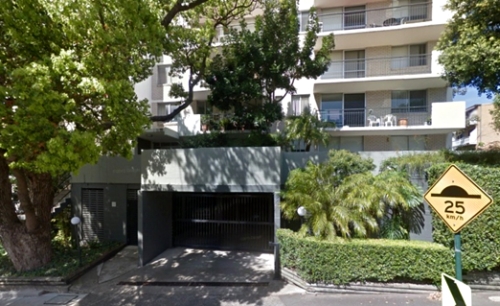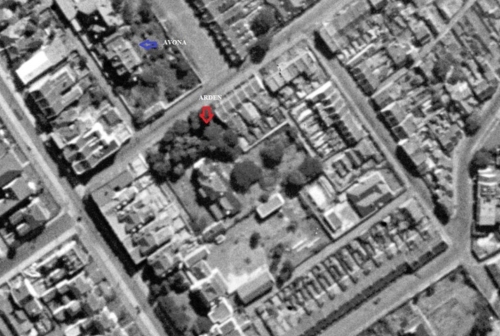My husband remembers days spent in his grandfather’s care as a five year old in the 1950s visiting a grand old house at Glebe Point from which his great uncle Bill ran a taxi cab depot. The house was in Forsyth St; it was approached by a gravel drive that encircled a classical fountain and off the drive were stables where his grandfather, an accountant, kept the books for Treharne’s Taxi Service.

The interior of the house included two large rooms either side of a central marble staircase, which led to a second storey containing six bedrooms. From their windows he glimpsed Blackwattle Bay, Wentworth Park and the city. Years later, in 1971, when he was driving trucks for white goods manufacturer Malleys, he made a delivery of refrigerators to 2 Forsyth St, Glebe. To his surprise they were bound for a brand new block of flats called Arden on the site of his great uncle’s former residence and place of business.

Later still when we lived in Forest Lodge diagonally opposite the old Nag’s Head pub and I crossed the footbridge each day to go to uni, he told me about the ‘mansion’ at Glebe Point that that had once been in the family. Impecunious and lovers of Glebe’s architecture, we felt wistful that any money the family once had was now long gone and that the house no longer stood.
It wasn’t until the genealogy bug bit me this century that I started to research the Treharnes of South Wales, who emigrated to New South Wales, living first in Newcastle and then in and around Sydney’s west. My husband’s family included:
- shrewd businessman William Maritime Treharne who owned a shop at 369 Glebe Point Road as well as the Forsyth St property;
- his parents William and Mary who resided for a time at 22 Mansfield St;
- his brother Llewellyn Emlyn, a tram driver who lived at 18A Boyce St;
- another brother, the celebrated Superintendent of Music at the Conservatorium, Herbert Fredrind Treharne, who lived in Burwood;
- my husband’s grandfather, John Steele Treharne, who lived in Annandale; and
- their sister Sina Jane who played piano beautifully and raised three children in Lilyfield.
Although 2 Forsyth St is now a block of flats, time travel of a sort is possible via an online tool called SIX maps which enables users to switch between modern day Google Maps-type imagery of Sydney and suburbs and a grainy black and white aerial survey of the same locations conducted by a company called SKM in 1943. We looked on SIX maps and found the fuzzy outline of the house William Treharne had owned for 50 years. My husband recognised the shape of the grounds and could show me where the stables stood. From then the quest was on to find a better image of Arden (we discovered the flats had adopted the name of the house they replaced) and to learn all that I could about its history.

As usual, I turned to TROVE, the National Library of Australia’s database of scanned newspapers, searched for ‘Arden Glebe Point’ and found numerous references to it in its incarnation as a Church of England Girls ‘Rescue’ Home directly before William Treharne first leased and then bought it in 1929. By googling the same terms I even found a copy of the original lease agreement between the church and great uncle Bill! A ‘rescue’ home was an institution where ‘fallen’ women could be redeemed and rehabilitated. The Glebe homes (they comprised four buildings) also catered to children whose families were unable to care for them and later, as ‘Hammond Hotels’ to entire impoverished families. Arden was the last of four buildings in Forsyth St acquired by the church for this purpose and served as the administrative office for the homes. The others were Strathmore (built 1857), the grand former home of Sydney businessman and politician Alexander McArthur, Tress Manning (built 1909) named after the Reverends T.B. Tress and Dr Manning, who set up homes, and Avona about which I was soon to learn more. A potted history of the homes appears on the Glebe Society’s website: https://www.glebesociety.org.au/?socialhistory=glebe-care-homes-for-children
In 1928 the Girls’ Home relocated to Minden in Carlingford leaving Arden and Avona vacant. Only a laneway separated Arden from William Treharne’s Glebe Point Rd shop above which he and his wife lived, and it seemed the perfect opportunity to extend his business and gain more spacious living arrangements.
We knew that uncle Bill retired to Sans Souci in 1971 and that Arden was sold to developers and demolished the same year; now it remained to work backwards and discover who had lived there before his family, and before Matron McGarvey and her rescued girls, and if possible who built the house. Again the Glebe Society came up trumps with a 2009 article in the series ‘Who Lived In Your Street?’ mentioning that Dr Rudolph Bohrsmann and family lived at Arden from 1907 until the church acquired it in 1918 and that he had purchased the house from wool merchant Eugene Carette.
I now had two new names to search on and gradually established the sequence of owners and residents at 2 Forsyth St. A breakthrough came when I realised that it was the Carettes who named the house ‘Arden’ and who added its second storey, a ballroom and a conservatory and that marble staircase in 1879. All earlier references to the property called it Forsyth Cottage and the land it occupied, the Forsyth Estate. Searching by ‘Forsyth’ I found ‘To Let’ advertisements where the contact was a Mr George Miller of Forsyth Cottage; these led me to believe that the house was frequently rented out yet that didn’t tally with birth announcements for the Miller family at the cottage. In the classified advertisements the house was described and my husband said it didn’t match his recollection of Arden’s layout. They also mentioned a croquet lawn and a rose garden. It turned out that the discrepancy was because these advertisements weren’t looking for tenants for Forsyth Cottage at all, but for a neighbouring property!
A bit more research and I made the happy discovery that in 1836-37 two dwellings were built on newly released land at Glebe Point overlooking Blackwattle Bay by a Mr George Miller (source: City of Sydney, History of Sydney Streets) I found bits and pieces about George Miller on TROVE but I wasn’t sure whether all the references were to the same man. I am indebted to the Manly Library Local Studies Blog for joining the dots so wonderfully in their fascinating post about how his widow, Sarah, came to be buried and commemorated in Manly Cemetery. (Source: Who was Sarah Ann Miller? http://manlylocalstudies.blogspot.com.au/2013/05/who-was-sarah-anne-miller.html. I draw on that post here).
Miller was a Scot who departed Britain’s shores for New South Wales aboard the Minerva in 1822. He worked for the Commissariat Department (army and navy stores) for nine years, posted first to Port Macquarie and then to Melville Island. The work was gruelling and took a toll on his health so he returned to Sydney to follow the less physically taxing profession of banking. Between the late 1830s and the 1850s he rose from clerk to Managing Trustee of the Sydney Savings Bank and was dubbed the ‘oracle in colonial banking’.
Miller built Forsyth Cottage as a home for himself and his new bride Sarah Bailey (widow of a fellow Commissariat employee) and built a second, grander residence nearby called Avon House/Lodge (later Avona). It was Avona that he regularly advertised as ‘to let’ in the newspapers in the 1840s and which boasted the rose garden and croquet lawn.
Sarah bore George seven children at Forsyth Cottage of whom one was stillborn, two died in infancy and four, Mary, Alice, Walter and George survived to adulthood. As well as acquiring his father’s name, George junior followed in his footsteps and became a prominent Sydney banker. What became of the others I haven’t discovered. Sarah’s father John Carmichael must have lived with the family or visited them as his place and date of death are recorded as Forsyth Cottage 1854. In 1855 Miller applied for two years’ leave of absence from the bank and returned to Scotland with his family on the Vimeira. He died suddenly in Edinburgh in August 1855 aged only 55 years.
Sarah, widowed for a second time, returned to Sydney to await the granting of probate, leasing out their Glebe home in the meantime. Between 1856 and 1858 engineer William Randle who contributed to the construction of the Glebe Island abattoirs and the roll out of the Great Southern Railway as well as much more of the Sydney rail network, lived at Forsyth Cottage.
In 1860 the house was put on the market and fetched £2,000. By 1863 it had been renamed Arden and become home to the Carette family. Eugene Carette, a Frenchman, was a successful wool buyer who lived and worked in Adelaide and Britain as well as NSW. He had a large family, three members of which were born at Arden in 1897, 1898 and 1900. The Carettes quit Arden in 1901 departing for France and selling off all their household furniture and effects at an onsite auction. Also listed for sale were a pair of bay horses and a ‘Superior Victoria carriage’ – all occupants of what later became the Treharne ‘office’ space. Poor Eugene Carette died in what must have been one of Paris’s earliest motor vehicle accidents in Paris in 1926 and his obituary in The Register of Adelaide stated that he left numerous other children besides those born at Arden and that ‘several of his sons’ worked in the family business.
Details about other occupants of Arden remain sketchy. In 1890, it is given as the address for Mr and Mrs Charles E. Graham, about whom I have been unable to discover anything. Export agent George Munro, lived there when he was fined for failing to report for juror duty in 1888 and when he and Mrs Munro hosted a lavish wedding reception for their daughter Ida and her groom Frank Learoyd there in 1894. Refreshments were served in one of the impressive downstairs rooms described as the ‘billiard room’. There seems to be something amiss with the chronology regarding these occupants although the Munros may have let the house for a time or, like my husband’s great uncle who offered accommodation to his employees at Arden, Munro may have rented rooms to the Grahams.
Progress with finding imagery was frustrating. Leichhardt Library holds surveyor’s drawings of the Avona and Forsyth estates only some of which are available online. The State Library of NSW has a Glebe subdivision plan that mentions the Arden Estate. I live outside Sydney and so far have been unable to view these. On a genealogy site I found and contacted descendants of the Millers (who knew nothing about Forsyth Cottage) and of the Bohrsmanns (who have yet to respond but who have attached to their family tree a tantalising photograph of Dr Rudolph playing backyard cricket in what might be the grounds of Arden).
However TROVE still had two further treasures to yield up! In the 11 May 1928 edition of the Sydney Morning Herald, under the snappy headline ‘C. of E. Girls’ Homes at Glebe Point, for the transfer of which to Carlingford an appeal has been launched’ appeared a photograph of the rescue homes’ administrative block. It shows the rear of a house, the girls and staff congregated around the back steps, a picket fence and washing on a line. Its function and location at ‘some distance from the main buildings’ as well as my husband’s memories confirmed it – it is Arden! The second was a newspaper advertisement that had eluded me on previous searches placed by the Church of England in July 1929. (See image below). It was an attempt to sell Arden as ‘a subdivision opportunity’ (passed in at auction) and contains a full description of the property as it existed when William Maritime resided there 1929-71.









3 comments. Please add yours.
Hi Jan,
The Glebe Society held it’s 50th Anniversary in June 2019 and members of the Heritage
Subcommittee spent 2.5yrs arranging an exhibition and producing a catalogue.
Forsyth Cottage was featured in the exhibition and in the process discovered a couple
of images. Please contact me so we can share this new information with you and discuss
further the information that you hold.
Regards
Robert
Hi Rhonda
William Treharne was my mother’s great grandfather.
My mother would love to get in contact with you if you would like to.
My email is redq02@gmail.com
Very interested in this. My husbands grandmother is Sina Treherne. In fact Sina had more than 3 children. I have been investigating Treherne family tree.